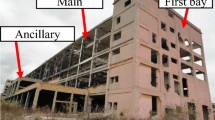Abstract
Today, one of the most important topics studied and researched in the construction industry is predicting how buildings will be damaged when accidents such as earthquakes or explosions occur. These accidents cause severe damage and lead to the destruction of some of the main members of the building. Progressive collapse is an example of a process that first leads to initial local damage and then leads to destruction of adjacent members or the entire structure. Due to the insufficient knowledge and information and the lack of a detailed analysis method that can consider the effective factors and mechanisms of resistance to progressive collapse, a more informed design is needed to ensure better performance against accidents. Since the proposed methods require high costs and time-consuming, more research is conducted in this field to better understand the influencing factors. In this research, five models of reinforced concrete frames with different dimensions and structural characteristics have been investigated under progressive collapse. This study has been done with the scenario of removing the middle column in progressive collapse based on nonlinear and numerical analysis using Abaqus software. As a result, by obtaining the area of the compressive areas of the concrete beam using the displacement force diagram, the optimal ratio of 5 was obtained by dividing the dimensions of the beam length by its height for dimension design. It can prevent accidents by more accurately predicting resistance mechanisms and compression areas of reinforced concrete beams of various structures. This ratio was investigated among these 5 models.





















Similar content being viewed by others
Abbreviations
- \(f_{c}\) (Mpa):
-
Compressive strength of concrete
- \(f_{u}\) (Mpa):
-
Ultimate strength reinforcements
- \(f_{y}\) (Mpa):
-
Yield of used reinforcements
- H :
-
Height of the cross section
- L :
-
Length of the concrete beam opening
- L/H :
-
The division of these two numbers and creating a ratio
- LR:
-
Longitudinal reinforcement
References
Liu C, Fung TC, Tan KH (2016) Dynamic performance of flush end-plate beam-column connections and design applications in progressive collapse. J Struct Eng 142(1):04015074
Valipour H, Nima V, Foster SJ, Samali B (2015) Influence of concrete compressive strength on the arching behaviour of reinforced concrete beam assemblages. Adv Struct Eng 18(8):1199–1214
Li Yi, Xinzheng Lu, Guan H, Ren P (2016) Numerical investigation of progressive collapse resistance of reinforced concrete frames subject to column removals from different stories. Adv Struct Eng 19(2):314–326
Almusallam T, Al-Salloum Y, Elsanadedy H, Tuan N, Mendis P, Abbas H (2020) Development limitations of compressive arch and catenary actions in reinforced concrete special moment resisting frames under column-loss scenarios. Struct Infrastruct Eng 16:1–19
Qiu L, Lin F, Wu K (2020) Improving progressive collapse resistance of RC beam–column subassemblages using external steel cables. J Perform Constr Facil 34(1):04019079
Li S, Shan S, Zhang H, Li Y (2019) Rapid retrofit of reinforced concrete frames after progressive collapse to increase sustainability. Sustainability 11(15):4195
Qian K, Weng Y-H, Li B (2019) Improving behavior of reinforced concrete frames to resist progressive collapse through steel bracings. J Struct Eng 145(2):04018248
Tsai M-H, Zhuang W-B (2020) An analytical approach for the flexural robustness of seismically designed RC building frames against progressive collapse. Int J Civ Eng 18:1025–1037
Kang S-B, Wang S, Gao S (2020) Analytical study on one-way reinforced concrete beam-slab sub-structures under compressive arch action and catenary action. Eng Struct 206:110032
Deng X-F, Liang S-L, Fu F, Qian K (2020) Effects of high-strength concrete on progressive collapse resistance of reinforced concrete frame. J Struct Eng 146(6):04020078
Zhang J-Z, Li G-Q, Jiang J (2019) Collapse resistance of RC beam–slab subassemblies due to column loss at large deflections. Mag Concr Res 71(12):647–663
Abbasnia R, Nav FM, Usefi N, Rashidian O (2016) A new method for progressive collapse analysis of RC frames. Struct Eng Mech 60(1):31–50
Lubliner J, Oliver J, Oller S, Onate E (1989) A plastic-damage model for concrete. Int J Solids Struct 25:299–329
Park R, Paulay T (1975) Reinforced concrete structures. John Wiley and Sons, New York
Azim I, Yang J, Farjad Iqbal M, Faisal Javed M, Nazar S, Wang F, Liu QF (2020) Semi-analytical model for compressive arch action capacity of RC frame structures. Structures 27(5):1231–1245. https://doi.org/10.1016/j.istruc.2020.06.011
Author information
Authors and Affiliations
Corresponding author
Ethics declarations
Conflict of interest
The author Seyed Iman Ferdows certify that he has no affiliations with or involvement in any organization or entity with any financial interest (such as honoraria; educational grants; participation in speakers’ bureaus; membership, employment, consultancies, stock ownership, or other equity interest; and expert testimony or patent-licensing arrangements), or non-financial interest (such as personal or professional relationships, affiliations, knowledge or beliefs) in the subject matter or materials discussed in this manuscript.
Ethical approval
This article does not contain any studies with human participants or animals performed by any of the authors.
Informed consent
For this type of study formal consent is not required.
Rights and permissions
Springer Nature or its licensor (e.g. a society or other partner) holds exclusive rights to this article under a publishing agreement with the author(s) or other rightsholder(s); author self-archiving of the accepted manuscript version of this article is solely governed by the terms of such publishing agreement and applicable law.
About this article
Cite this article
Ferdows, S.I. Examining the changes in the dimensions of the structure and its effect on the compressive zone and resistance functions against progressive collapse. Innov. Infrastruct. Solut. 8, 189 (2023). https://doi.org/10.1007/s41062-023-01151-4
Received:
Accepted:
Published:
DOI: https://doi.org/10.1007/s41062-023-01151-4




